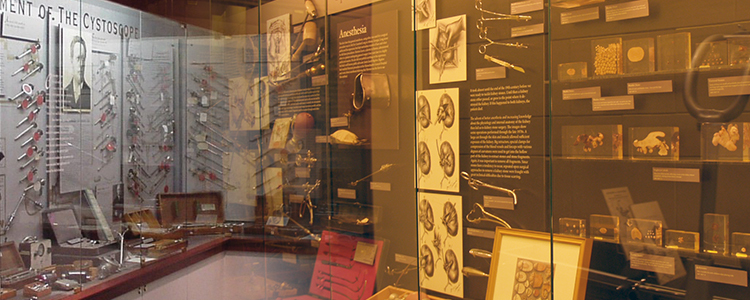
The William P. Didusch Center for Urologic History of the American Urological Association (AUA) is located at the AUA headquarters in Linthicum, MD. The Didusch Center is named in honor of William P. Didusch, a world-renowned medical artist at the Johns Hopkins Brady Urological Institute, and the first curator of the AUA's museum. The museum was conceived by Didusch and opened in 1971. Didusch remained curator until his death in 1981, and was succeeded by Dr. Herbert Brendler. Dr. William W. Scott—who worked with Nobel Laureate Charles Huggins at the University of Chicago and later became director of the Brady Urological Institute at Johns Hopkins Hospital—assumed the position upon Brendler's death in 1986. Dr. Rainer Engel, also of Johns Hopkins, became curator in 1993 until Dr. Michael Moran took over in 2011. Today, the Didusch Center has a curatorial team, led by an annual Exhibits Curator
The Didusch Center encompasses a rich and varied collection of drawings, photographs and instruments of historical importance to urology, many displayed in our urological exhibits. The center also houses a library devoted to urological and early medical texts and the AUA archives.
The museum collection features most of Didusch's original drawings, as well as an impressive instrument collection—gained primarily through donations by urologists such as Dr. Ernest F. Hock of Binghampton, NY, Hans Reuter of Stuttgart, Germany and Dr. Adolf A. Kutzmann of Los Angeles. There are also many antique medical books and modern texts. Donations continue to come to the center, where they are carefully catalogued and stored for study and future displays. Donations of materials or funds are appreciated.
Among the instruments are early Nitze cystoscopes from 1890 with platinum loops for illumination, a Nitze Cystoscope used to cauterize bladder tumors with a platinum wire at the end of the instrument, walking canes to hold catheters, rotating cystoscopes and operating resectoscopes, old electro-surgical units, glass jars and cabinets for sterilizing urologic instruments using formaldehyde or cyanide and innumerable cystoscopes from the incandescent bulb era up to the present fiber-optic systems. Another interesting acquisition is a collection of more than 30 microscopes dating back to the 1700s and books about these instruments. This stunning collection was part of a private urology museum owned by a German urology family. The microscopes are on a long-term loan to the Didusch Center.
The original William P. Didusch Museum (now known as the William P. Didusch Center for Urologic History) was originally housed in the AUA's Baltimore City headquarters building. Upon the association's move to Linthicum, MD in 2003, the museum has evolved into the William P. Didusch Center for Urologic History and taken on new tasks and responsibilities that include a research library and archives.
Mission/Vision
To preserve, document and present the history of urology and the American Urological Association as we educate, engage, and inspire the medical community and the public about the history of urology to better understand its impact on today's healthcare environment and provide insight into the future.
